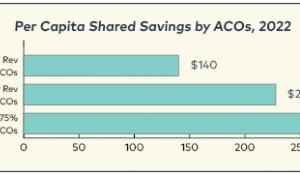Veterans Health Administration - Patient Aligned Care Team (PACT)
Program Location:
Washington, DC
Payer Type:
Military
Payers:
TRICARE
Reported Outcomes






Description:
The VA’s Veterans Health Administration (VHA) operates one of the largest integrated health delivery systems in the United States, delivering comprehensive care to approximately five million Veterans. VA’s PCMH Patient initiative includes a care team model that incorporates multidisciplinary clinical and support staff who deliver all primary care and coordinate the remainder of patients’ needs, including specialty care. To optimize workflow and enhance continuity of care, staff are organized into “teamlets” that provide care to an assigned panel of about 1,200 patients. A teamlet consists of 1 PCP, 1 registered nurse (RN) care manager, 1 licensed practical nurse (LPN) or medical assistant, and 1 administrative clerk. In addition, the program instructs facilities to enact advanced access scheduling, including same-day appointment slots. Facilities are also asked to conduct more appointments via phone and group appointments.
Related News & Resources
Fewer ED / Hospital Visits:
American Journal of Managed Care (March 2015) During the study period from just prior to widespread PACT implementation to 2 years after PACT implementation began
- ED visits per patient rose slightly (7%), and ACSC hospitalizations per patient also rose from 0.02 to 0.03 per patient (all P <.001)
Journal of Health Care Quality (November 2014) study evaluated PACT patients with post traumatic stress disorder using a pre/post study design
- PACT were associated with:
- a decrease in hospitalizations (incremental effect [IE]: -0.02; 95% confidence interval [CI]: -0.03, -0.01)
- a decrease in specialty care visits (IE: -0.45; 95% CI: -0.07, -0.23)
Health Services Research (August 2014)
- Slight decline in ED visits among PACT providers (9.7% to 8.0%) while they increased for patients seen by non-PACT providers (7.5% to 8.8%)
JAMA Internal Medicine (June 2014)
- Lower emergency department use (188 vs 245 visits per 1000 patients; P < .001
- Lower hospitalization rates for ambulatory care–sensitive conditions (4.42 vs 3.68 quarterly admissions for veterans 65 years or older per 1000 patients; P < .001)
Health Affairs (June 2014)
- 1.7% reduction in hospitalizationsf for ambulatory care sensitive conditions across the entire VHA system; 4.2% reduciton for veternas under age 65
- 7.3% reduction in outpation vistisn with mental health specialists across VHA system (likely due to integration of mental health in primary care)
Plos One (May 2014)
- Individuals with at least one visit to their assigned primary care provider (PCP) were less likely to visit the ED compared with those lacking a single PCP visit ( 23% v. 32%, p<.001)
- 46% reduction in ED utilization due to continuity of care
American Journal of Managed Care (July 2013)
- Decrease in face-to-face primary care visits (53 to 43 per 100 patients per calendar quarter (p<.01)
- Patients evaluated within 48 hours of inpatient discharge increaed 6% to 61% (p<.01)
Improved Health:
JAMA Internal Medicine (June 2014)
- PCMH group had higher performance on 41 of 48 measures of clinical quality
- Veterans with chronic disease had small but significant improvements in qualtiy-of-care indicators
- Improvements in clincial outcomes for patients with diabetes, hypetension and heart disease
Improved Patient/Clinician Satisfaction:
American Journal of Managed Care (June 2015)
-
no statistically significant association between medical home implementation and improvements in 5 domains of patient care experiences
JAMA Internal Medicine (June 2014)
- clinician satisfaction: lower staff burnout in PCMH vs nonPCMH (2.29 vs 2.80; P = .02)
- patient satisfaction: higher scores of patient satisfaction (9.33 vs 7.53; P < .001)
Improved Access:
VA Health Services Research & Development (February 2019)In 2012, select Veterans Health Administration (VHA) facilities implemented a homeless-tailored medical home model, called Homeless Patient Aligned Care Teams (H-PACT), to improve care processes and outcomes for homeless Veterans.
- H-PACT patients were more likely than standard primary care patients in the same facilities to report positive experiences with access [adjusted risk difference (RD)=17.4], communication (RD=13.9), office staff (RD=13.1), provider ratings (RD=11.0), and comprehensiveness (RD=9.3
American Journal of Managed Care (March 2015) During the study period from just prior to widespread PACT implementation to 2 years after PACT implementation began
- 17% decreased in mean number of primary care visits (from 4.81 to 3.99 visits per patient) and 85% increase in telephone visits (P <.001)
- "Features such as team huddles and tracking lab tests were actually associated with fewer primary care visits per patient, possibly through better efficiency of primary care practice. Greater specialty care visits were modestly related to higher care coordination/transitions in care scores, so better procedures to coordinate care appeared to facilitate referrals to specialty care."
Journal of Health Care Quality (November 2014) study evaluated PACT patients with post traumatic stress disorder using a pre/post study design
- PACT were associated with an increase in primary care visits (IE: 0.96; 95% CI: 0.67, 1.25)
Health Affairs (June 2014)
- 3.5% increase in primary care visits for veterans over age 65
- 1% increase in primary care visits across VHA system (all age groups)
American Journal of Managed Care (July 2013)
- Increase in phone encounters (2.7 to 28.8 per 100 patients per quarter)
- increase in personal health record use (3% to 13% of patients enrolled)
- increase in electronic messaging to providers (.01% to 2.3% of patients per quarter)
- increase in same day appointments (p<.01)
- increase in patients seen within 7 days of desired appointment date (85% to 90% p<.01)
Increased Preventive Services:
JAMA Internal Medicine (June 2014)
- Veterans receiving care from sites with successful PACT implementation were more likely to:
- get a flu shot (p<.001)
- get screeened for cervical cancer (p<.047)
- ger offered medications for tobacco cessation (P<.001)
Other Outcomes:
American Journal of Managed Care (March 2015) During the study period from just prior to widespread PACT implementation to 2 years after PACT implementation began
- The mean total costs of VA care increased from $8469 to $9887 per patient during the study period (P <.001)
- The only significant increase in costs was explained by high risk or worse comorbidity (P <.001), none of the PCMH component scores were significantly related to total costs per patient
- High organization of practice scores was significantly related to 0.13 fewer mean primary care visits per patient compared with patients in low-scoring clinics (P = .012).
- High care coordination and transitions in care scores were significantly related to 0.06 more specialty care visits compared with the low scores (P = .010), after controlling for patients’ health status and time trend.
- High scores in care coordination and transitions in care decreased the mean number of ED visits by 0.04 visits per patient (P = .018)
- High quality and performance improvement increased ED visits by 0.03 visits per patient (P = .032), relative to low scores.
Health Affairs (June 2014)
The study found, "PACT was associated with modest increases in primary care visits and with modest decreases in both hospitalizations for ambulatory care–sensitive conditions and outpatient visits with mental health specialists. We found that these changes avoided $596 million in costs, compared to the investment in PACT of $774 million, for a potential net loss of $178 million in the study period. Although PACT has not generated a positive return, it is still maturing, and trends in costs and use are favorable. Adopting patient-centered care does not appear to have been a major financial risk for the VHA."
Data Source(s):
Last updated March 2019
Secondary menu
Copyright © 2024 Primary Care Collaborative




